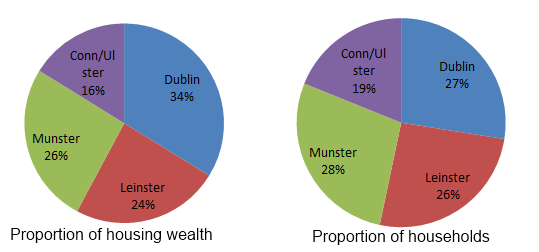Wealth taxes and property taxes in Ireland: understanding the tax base
The end of the first quarter of 2012 saw not just the usual quarterly reports – such as the Q1 2012 Daft.ie House Price Report discussed elsewhere on the blog – but also the deadline for paying the €100 Household Charge. The charge has been the focus of a campaign of resistance that is surely more to do with the principle than its size (the increase in Band A motor tax was almost as large as the Household Charge but I don’t recall anyone complaining against that particular flat tax).
In fact that campaign has succeeded in one way already: while it had originally talked about the charge applying for 2-3 years on an interim, the Government is now not going to go through all this again and desperately wants to bring in a fairer property tax with Budget 2013 this coming December.
Where’s all the property wealth?
What sort of base is there for property tax? The latest Daft.ie Report gives county-by-county figures, which can be combined with information from 2006 and subsequent completions (or alternatively Census 2011 information) to reveal what wealth there is in residential real estate around the country.
The total amount of wealth in residential property peaked in 2007Q4, at €564bn. 37% of all this wealth (€208bn) was in Dublin (home to just 28.5% of households in 2006). A further €37bn was in the four other cities – their 6.5% being roughly in line with their 7% share of all households. Since then, the trickle of new completions has not been nearly enough to offset the fall in property values. The stock of homes as of Census 2006 has fallen in value from €525bn to €255bn, as of Q1 2012, while including the value of new completions in the years since 2006 increases the total value of all residential property to €294bn.

Dublin is now home to just under €100bn of housing wealth, as of early 2012, while the rest of Leinster and all of Munster are home to €70bn and €76bn in housing wealth respectively. Connacht and the three Ulster counties are home to about €48bn of housing wealth. The relative proportions that each of four regions makes up of Irish housing wealth and Irish households is shown in the two pie charts above – you can see that rural households need have no fear that any property tax will hit them hardest. Quite the reverse: any property tax will have to make sure that it doesn’t overly punish urban life, which is so crucial to subsidising the rest of the country.
Where’s all the wealth?
These are statistics that the political class would do well to heed. To recap our Econ1010, there are three main types of tax: those on incomes, those on consumption and those on wealth. Ireland is also home to some of the world’s most punitive rates of taxation on income and consumption, so hence there is increasing interest in wealth taxes.
There are four main forms of wealth: (1) cash/deposits, (2) equities/shares, (3) debt/bonds, and (4) real estate/property. In Ireland, as of 2006, deposits made up 10% of Irish wealth, equities a further 8%. Pension and investment funds – wealth holdings of unknown type but likely to be a mix of mainly equities and bonds – made up a further 11% of wealth. But it was property that was the overwhelming type of wealth in Ireland, making up 72% of all wealth. The vast bulk of this was residential property. And that picture is not likely to have changed substantially with so much of Irish equity wealth being invested in the banks, which are now all next to worthless.
So when people talk about taxing wealth in this country, they are talking principally about taxing the homes that we live in. In second place comes taxing the deposits we have in the bank. Make sure to mention this to the next person who says “We don’t need a property tax, we need a wealth tax”.